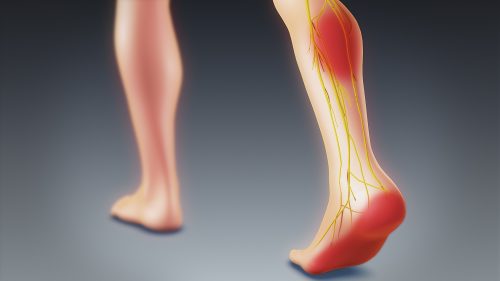The knee pain ou knee pain can have many causes including sciatica which we do not always think about, especially when the pain is located on the back of the knee.
But what is the connection between the sciatica and the pain behind the knee? Answers in this article.
Anatomical reminder
Knee
The knee is a joint complex that connects the thigh to the leg, it is formed of two inseparable joints namely:
- The joint connecting the femur (thigh bone) to the tibia (one of the two bones of the leg) called femoro-tibial;
- The patellofemoral joint connecting the femur to the patella (patella).
These joints are formed thanks to four articular surfaces covered with a cartilage ensuring their sliding, it is about the femoral trochlea, the femoral condyles, the tibial plates and the patella.
Sciatic nerve
Considered the most voluminous nerve in the human body, the sciatic nerve is a sensory-motor nerve of the lower limbs formed by nerve fibers from the roots ranging from L4 to S3.
To learn more about the anatomy of the sciatic nerve, you can read the following article:
Sciatic nerve: Anatomy and route (Associated pathologies)
What are the pathologies of the knee?
The knee can be the site of pathologies that can affect the different anatomical structures forming it. Although different, they have their symptoms in common: pain (gonalgia), stiffness and sometimes functional impotence. Thus, we distinguish:
- Tendinitis: it is a painful inflammation of a tendon occurring in a traumatic way during a shock or a false gesture occurring during a physical activity, the best known is the crow's feet tendonitis.
- Ligament injuries: it can be a ligament elongation giving a slight sprain or the tearing of a ligament or several ligaments causing a severe sprain such as during the rupture of the cruciate ligaments.
- Meniscal injuries: they occur after constraints that can occur suddenly and give traumatic lesions such as cracking, disinsertion or tearing of the meniscus ; or repeatedly causing degenerative lesions such as meniscosis affecting the elderly. It more often affects the internal meniscus than the external one.
- Synovial damage: the latter may be the seat of an excessive production of synovial fluid giving a synovial effusion. The synovial or joint fluid can also be trapped within a pocket forming a ball appearing behind the knee, this is the Baker's cyst or popliteal cyst.
- Joint damage: the different joints can be the seat of osteoarthritis called gonarthrosis. Trauma can also cause the effusion of blood at the level of the joint causing a knee hemarthrosis.
- Bone lesions: the bones forming the knee joint (femur, tibia and patella) can be, following a violent trauma, the seat of broken bones.
- Gonalgia due to sciatica.
Can sciatica cause pain behind the knee?
La sciatica is pain of neurological origin due to irritation or compression of the root of the sciatic nerve. It originates in the lumbar region (in the lower back) and radiates along the leg through the buttocks, the back of the thigh, behind the knee, the posterior or external face of the calf and ending at the level of the foot.
As a result, sciatica can cause pain behind the knee, given the passage of the sciatic nerve through the popliteal fossa.
Things to do
When pain occurs suddenly or gradually behind the knee, the first thing to do is obviously to consult a doctor in order to make an accurate diagnosis.
During the consultation, the doctor will carry out a complete examination in order to orient himself as to the cause of the gonalgia. He will look for a notion of trauma, fever or a history of similar pain.
He will also be interested in the time of onset of the pain as well as the existence of an origin and a painful route directing towards gonalgia due to sciatica.
The physical examination also represents a very important part of the consultation, it will be done in two stages:
- First in a standing position: to look for the presence of a deformity, lameness or pain caused or increased when walking on the heels or on tiptoes.
- Then while lying on your back: to examine the ligaments, menisci and muscles forming and surrounding the knee. As well as to look for a possible fluid effusion.
Finally, depending on the results of the consultation, the doctor may need to request a plain x-ray initially, especially when there is a trauma, or a soft tissue ultrasound looking for fluid in the joint or a popliteal cyst.
Le scanner (CT), theIRM and bone scan are only requested as a second intention.
At the end of all the investigations, when the doctor retains the diagnosis of gonalgia secondary to sciatica, specific care can be put in place with, in particular:
- The prescription ofanalgesics first-tier drugs such as paracetamol, nonsteroidal anti-inflammatory drugs and corticosteroids;
- The recommendation to use physical means to reduce pain such asapplying heat at the lumbar level;
- The indication of sessions of physiotherapy in order to adopt the right gestures, strengthen their muscles and thus avoid recurrences.
To learn more about sciatica and its management, you can consult the following article https://www.lombafit.com/sciatique-a-z/
References
https://facmed-univ-oran.dz/ressources/fichiers_produits/fichier_produit_2310.pdf
http://anatomie-fmpm.uca.ma/wp-content/uploads/2020/06/18-Le-genou-.pdf
https://www.revmed.ch/view/860052/6857594/RMS_2381_480.pdf
https://www.doctissimo.fr/html/sante/encyclopedie/sa_1219_genou.htm#les-maladies-extra-articulaires
https://www.ameli.fr/assure/sante/themes/gonalgie/definition-symptomes-causes
My name is Sidali. I am a general practitioner and Web Editor. As a healthcare professional, my mission is to contribute to the relief of my patients' ailments. Being also passionate about writing, I have the pleasure of sharing my solid medical knowledge with the greatest number of readers, by writing popular articles that are very pleasant to read.


